25 Eye-Catching Images From The Popular Selection Stage Of The 2021 Wildlife Photographer Competition
25 Attractive And Beautiful Works From The Wildlife Photographer Of The Year Contest Were Shared For The People’s Choice Award Stage.
The Wildlife Photographer of the Year competition, organized by the Natural History Museum, shared 25 shortlisted photos from among the entries. These images are now in the stage of popular choice.
The Wildlife Photographer of the Year competition is recognized as a global platform for amateur and professional photographers, and millions see the photos presented in this competition of people worldwide.
The 2021 competition shared more than 50,000 photos from 95 countries. The following 25 images were displayed in the Wildlife Photographer of the Year exhibition at the Natural History Museum in London.
The mentioned photos were placed for voting on the website of the Natural History Museum. The top five People’s Choice Award images will also be displayed online. They will join the winners of the 57th Wildlife Photographer of the Year competition, Winners selected by a panel of judges.
The ice bear cometh
By Andy Skillen, UK
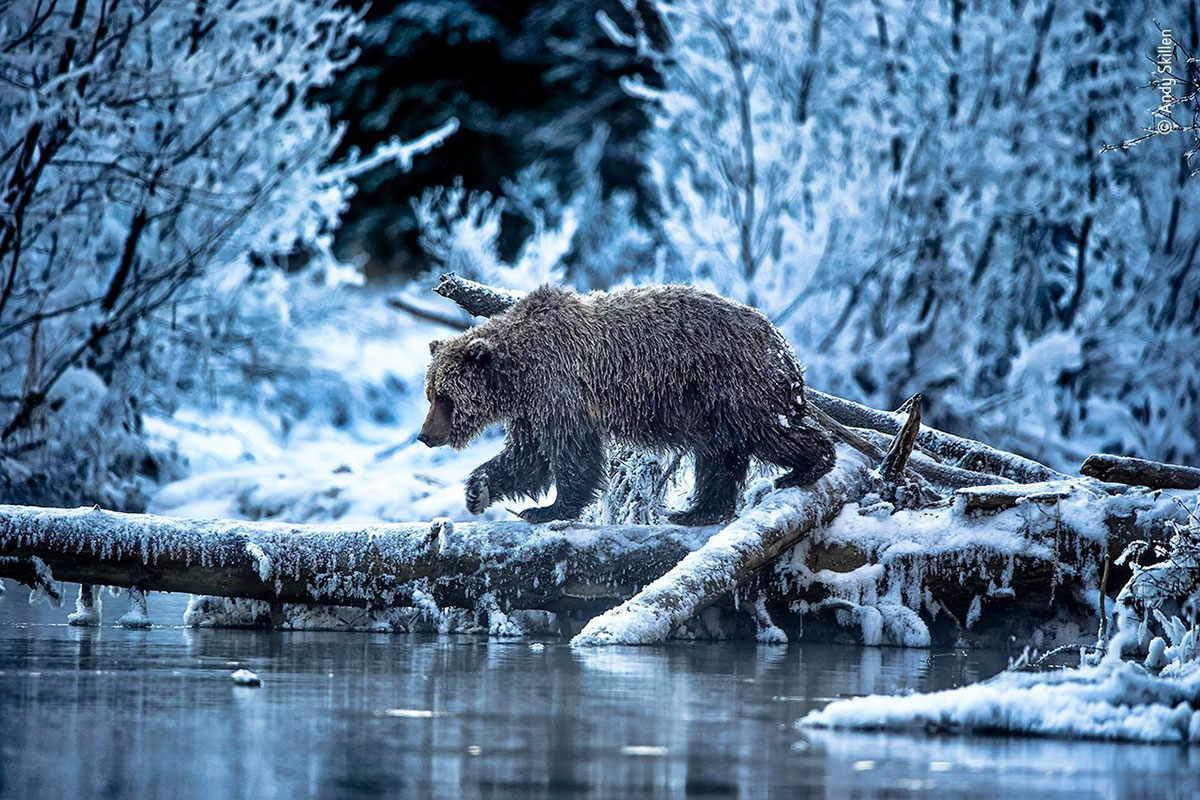
If you travel by helicopter from the nearest city to this point in the Canadian Yukon, you will need two hours; A river that never freezes regardless of how cold the weather is. In late autumn, salmon swim in this area. For grizzly bears, the open water of Canada’s Yukon offers one last chance to feast before hibernation. The average air temperature was around minus 30 degrees Celsius. Andy hoped that a particular female bear would use this log to cross the river. Finally, the bear did that achieving the image he had in mind. Andy says the bear’s hair was wet and frozen.
Lynx cub licking
By Antonio Libana Navarro, Spain
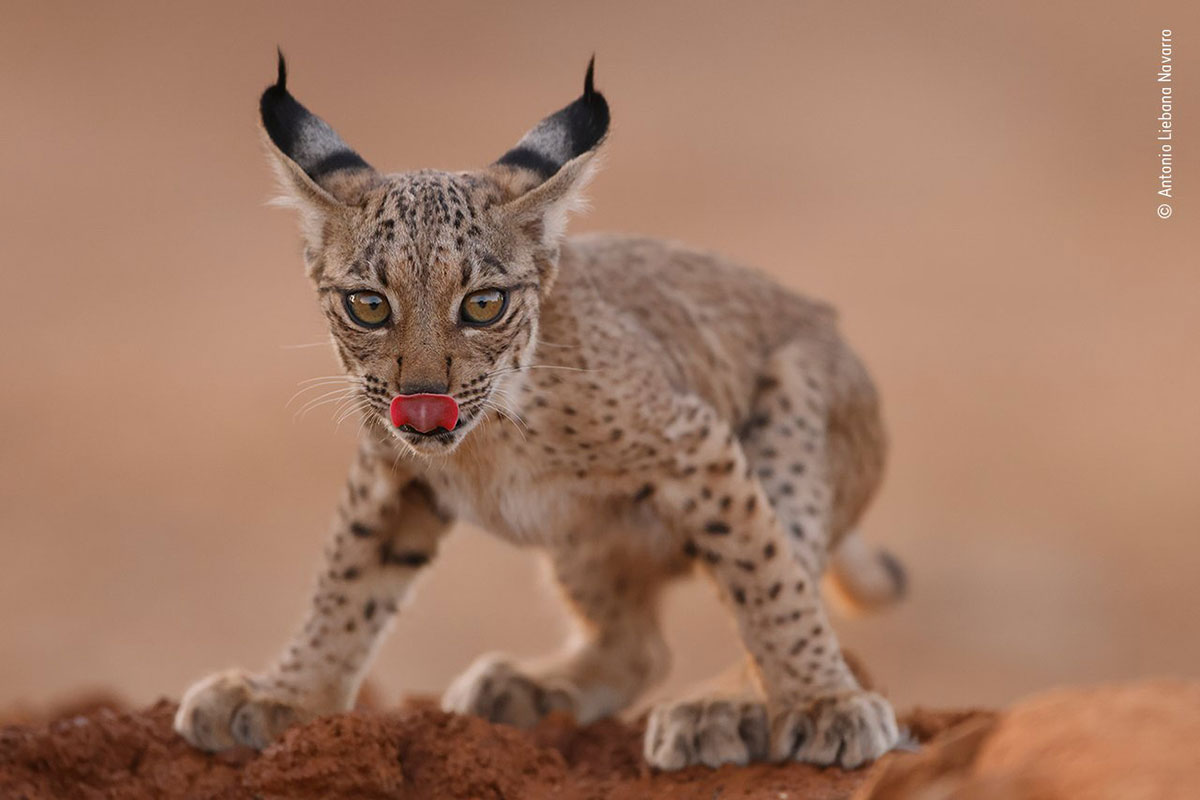
The Iberian lynx is considered one of the most endangered cats in the world due to loss of habitat, reduction of food sources, accidents with cars, and poaching; But thanks to conservation efforts, the species is recovering and can be found in small areas of Portugal and Spain. Antonio captured the image above while leading a photography-based conservation project in Penalejo, Castilla La Mancha, Spain. He knew that a family of lynxes was using a nearby hole for drinking water, so he lay in wait nearby. He focused more on the lynx cub and captured the moment when the lynx lifted its head from the water, licked its lips, and stared directly at the camera.
Shelter from the rain
By Ashley McCord, USA
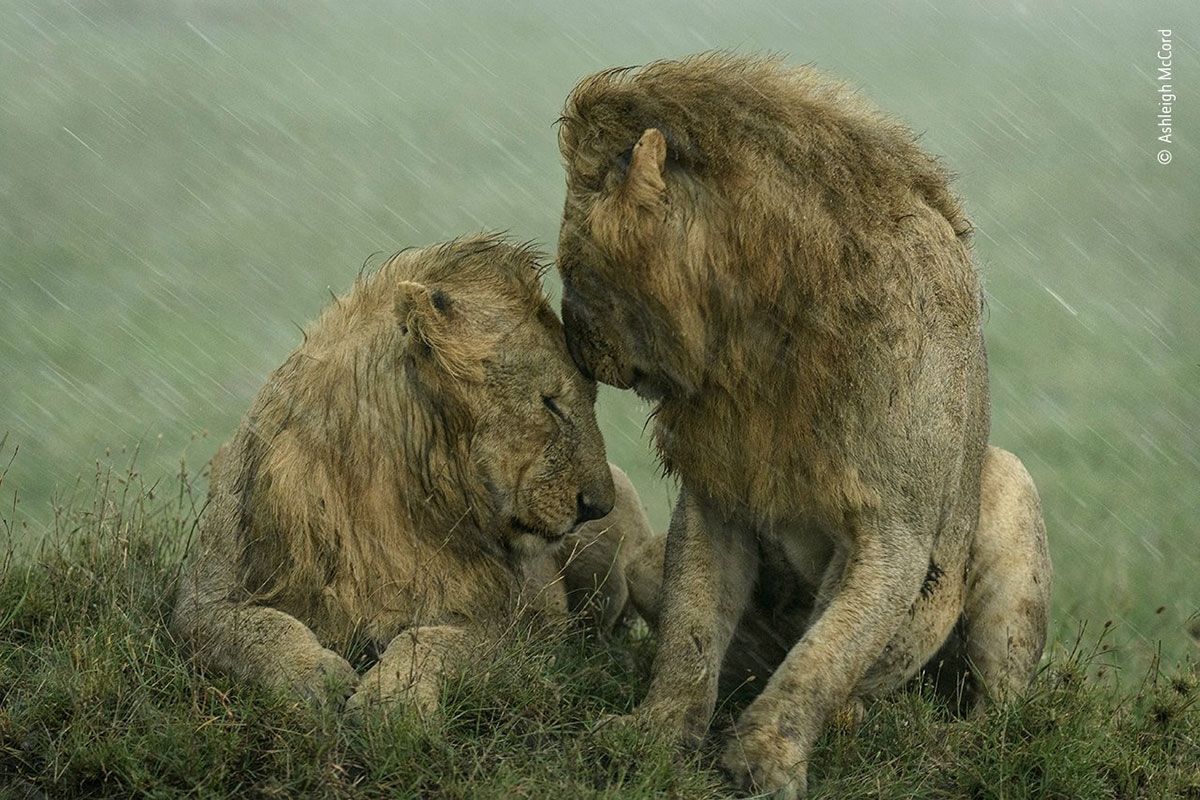
Ashley captured this emotional moment between two male lions while visiting Kenya’s Maasai Mara. At first, he was only photographing one of the lions, and the rain was light, at which point the second lion approached the other for a short time and continued on his way again. Still, when the rain became heavy, the second male lion came back, sat down next to the first, and positioned his body as if to shelter it. After a while, the two lions rubbed their faces together. Ashley looked at them until the rain became too heavy to see.
Lake of ice
By Cristiano Vandramin, Italy
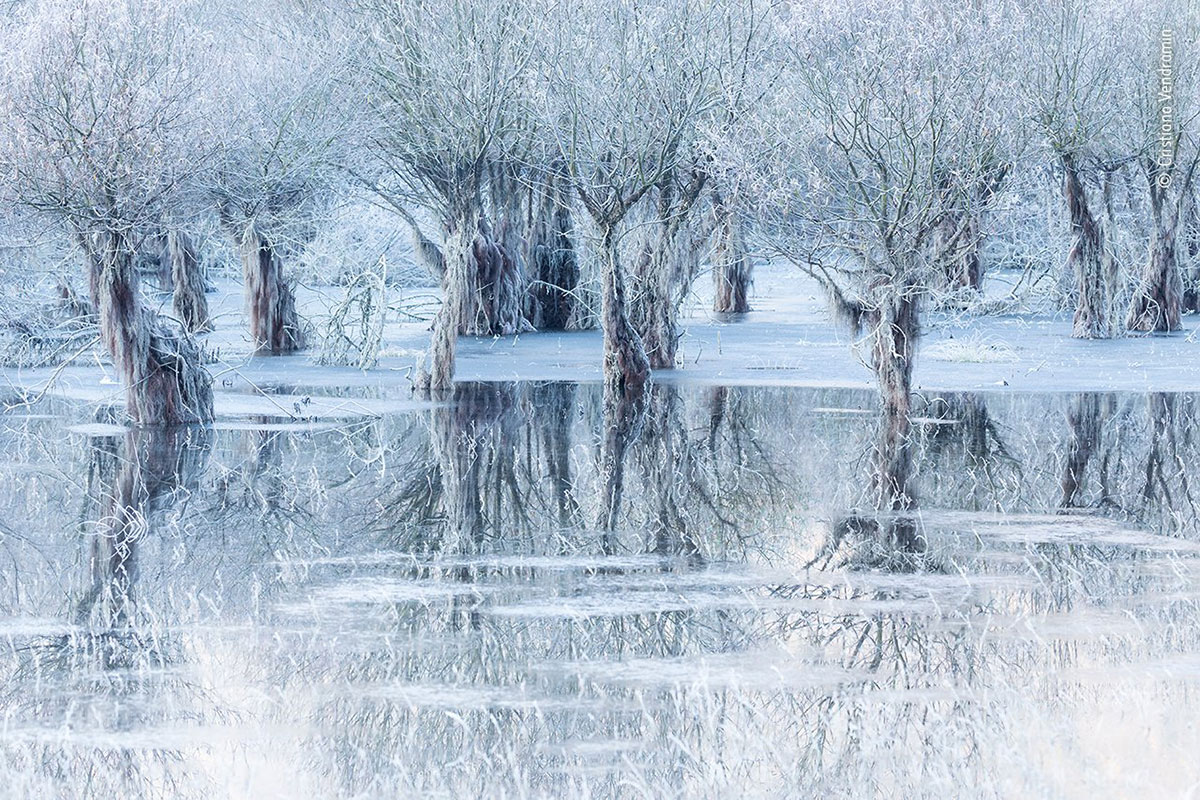
Santa Croce is a natural lake located in Belluno, Italy. In the winter of 2019, Cristiano noticed that the water was unusually high, and the willow plants partially submerged, creating a unique reflection. He managed to record the scene you see in icy silence. After taking the photo, he remembered a dear friend who loved this place and was no longer here. Vendramini said:
He gave me a feeling I will never forget. That’s why I dedicate this photo to him.
Jaguar of ashes
By Ernan Jr., Brazil
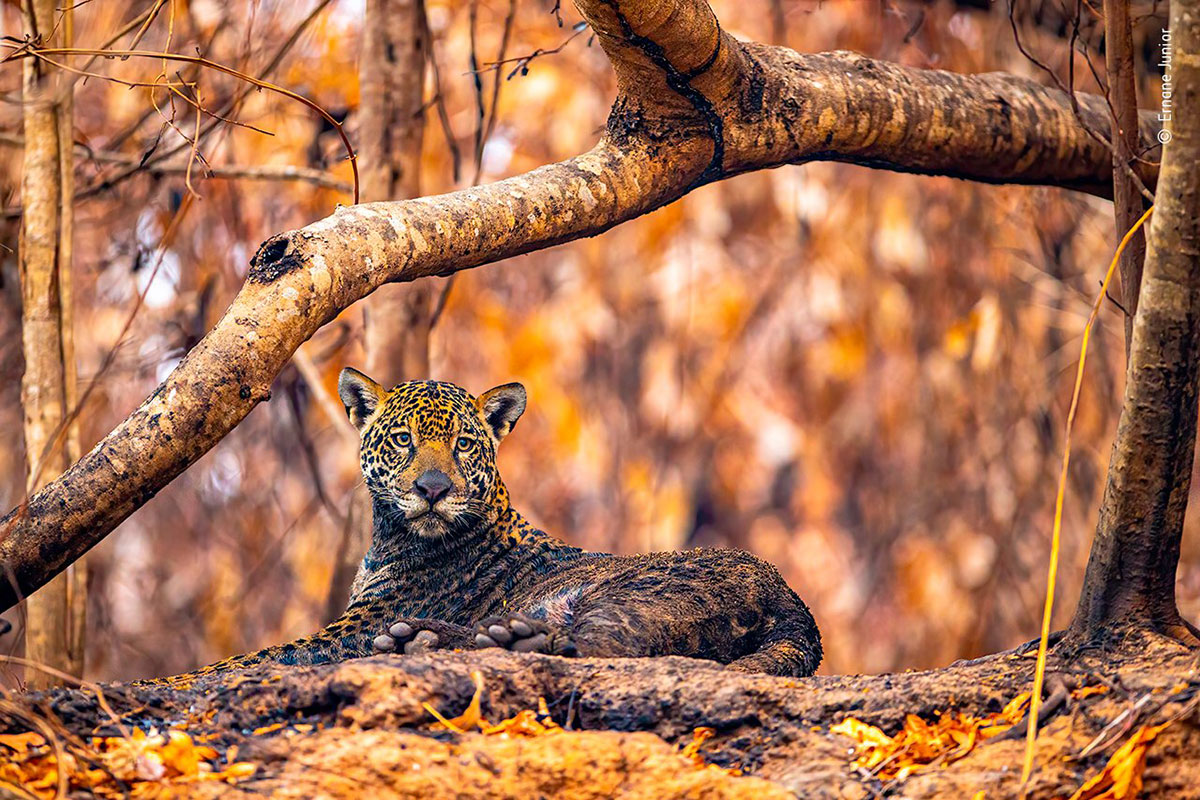
2020 saw a doubling of fires in the Brazilian Pantanal wetlands compared to the previous year, a year that will never be forgotten. More than 26% of the entire region was affected by the fire. The situation was worse in Encontros dos Aguas State Park, almost 80 percent burned. This park is known for its large jaguar population. Hernán, who went there to document the fire, encountered this jaguar and his brothers near the Three Brothers River (Rio Três Irmãos). After reaching the opposite bank, the jaguar rolled in the ash left by the devastation of the previous days and did not just bury its face in it. The black jaguar’s body was a mirror of the surrounding environment.
Dolphin hug
By Jamie Rojo, Spain

Jamie witnessed a dolphin being tranquilized by Federico Mescura, a biologist at the Umachai Foundation in Colombia, in the Amazon River. These dolphins are animals that like to be touched, and direct contact calms them down; Keeping them hydrated outside of the water is also very important. The Omaha team and WWF were transporting the dolphin to a temporary veterinary facility in Puerto Nariño, Colombia, to install a GPS tag on its dorsal fin. The project is part of a broader scientific effort to understand river dolphin health and migration patterns. The goal was to mark five dolphins, but due to the environmental conditions, this did not happen, and finally, only one dolphin was marked.
Blackbird backyard
By Jan Lessmann, Germany

Jan enjoyed watching this blackbird from the front door of his home in his hometown of Greifswald, Germany. With the picture above, John wanted to remind us that we don’t have to go far to experience the beauty of nature; sometimes, something as simple as a black hen making its home in a dilapidated hut is enough. It was spring, and the blackbird had chosen an old garden hut to build a nest in. The bird quietly and secretly reared its young in the great garden.
Building an egg case
By Javier Aznar González de Rueda in Spain
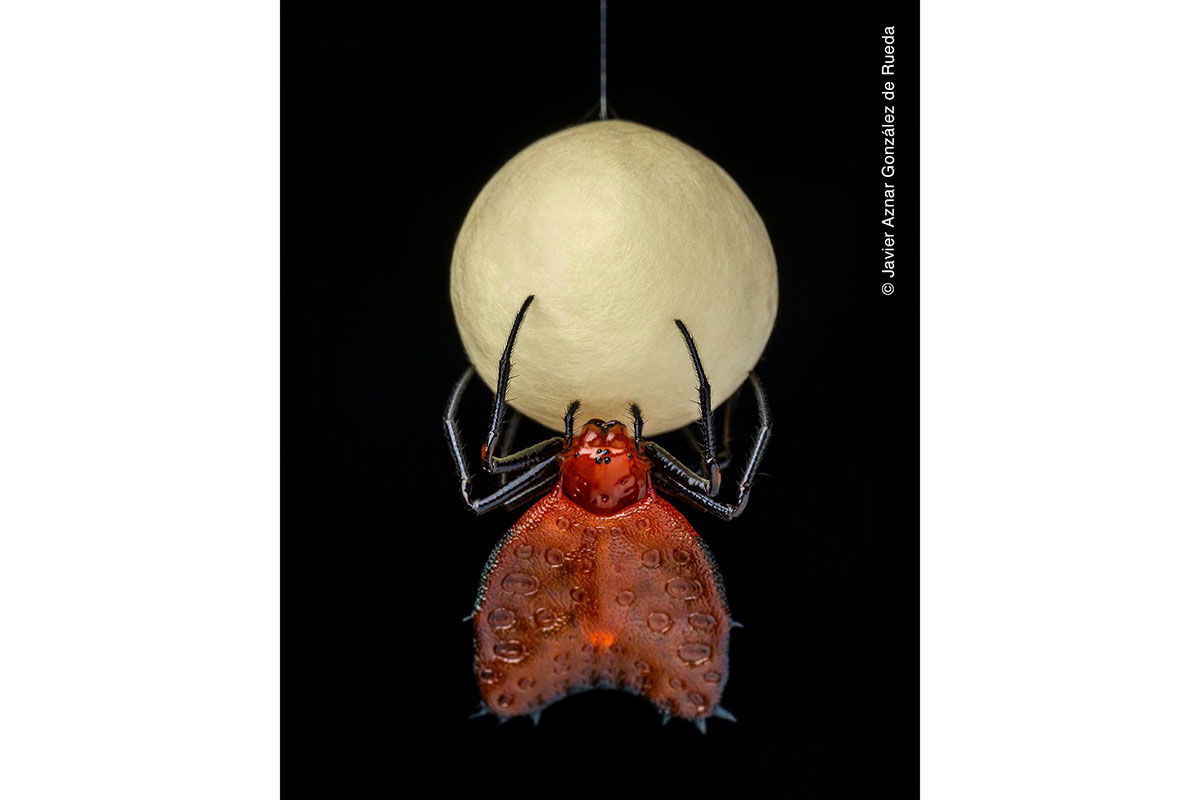
During a night hike in the Amazon rainforest near Tena, Ecuador, Javier spotted this tiny female orb spider delicately building her egg case. Hanging from a strong silk thread, female spiders spend hours enclosing their eggs in a cocoon that may contain hundreds of eggs. In the darkness of the night, the egg box looked like a full moon, the color of pearls.
The eagle and the bear
By Jeroen Hoekendik, Netherlands
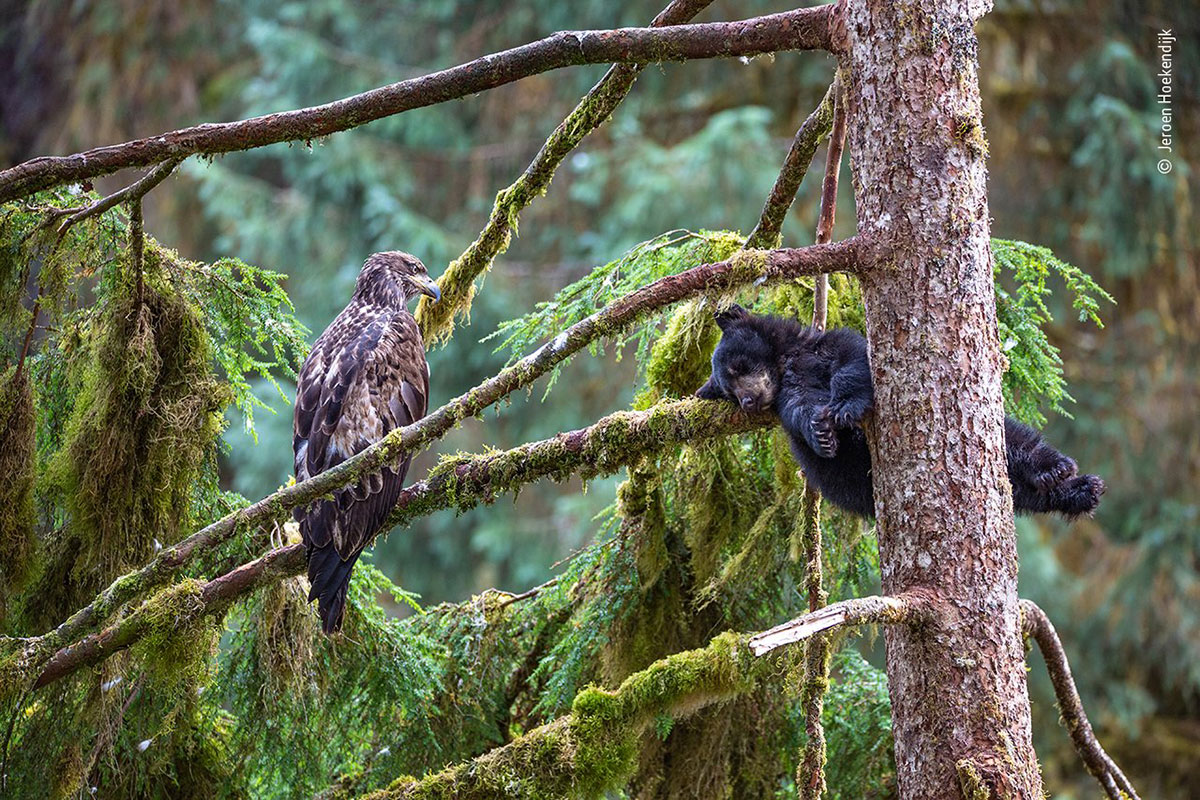
Black bear cubs often climb trees, where they safely await their mother’s return with food. Deep in Alaska’s Anan Temperate Rainforest, this tiny cub decided to nap on a moss-covered branch under the watchful eye of a juvenile bald eagle. The eagle was sitting on the pine tree for hours, and Yron saw this scene as an extraordinary situation for photography. He quickly changed his location, so he went to the top of a hill and took a picture of the unsuspecting bear.
Hope in a burnt plantation
By Jo Ann MacArthur, Canada
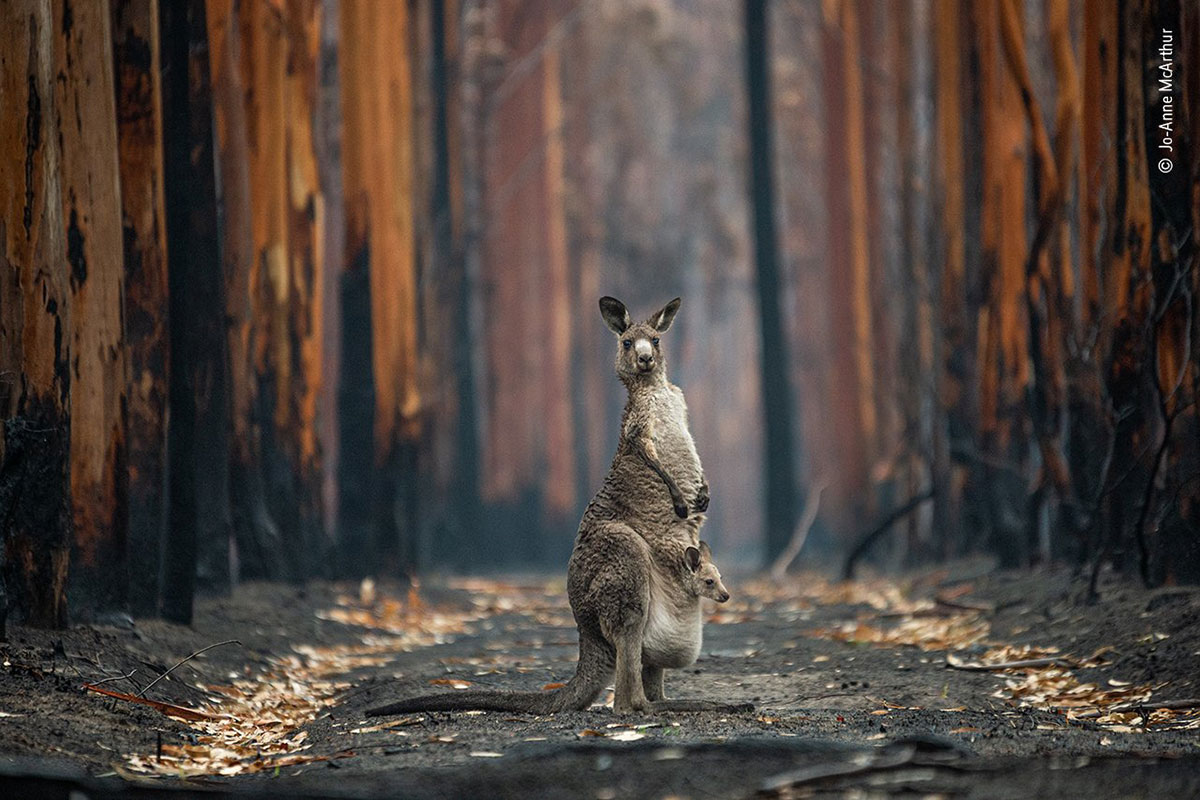
Jo-Anne flew to Australia in early 2020 to document the animals affected by the devastating bushfires in New South Wales and Victoria. Because Jo-Ann worked with Animals Australia, so she was given access to burn sites, rescue animals, and various missions. This eastern gray kangaroo and her baby, pictured near Victoria’s Malakota, were among the lucky animals. Kangaroo did not take his eyes off Jo-Ann. Still, the photographer could press the shutter of his camera before the kangaroo reached the burnt eucalyptus plantation and captured such an image.
The future is in her hands.
By Juan de la Mala, Spain

Borneo’s rainforests are rapidly disappearing due to overexploitation (industrial logging and land clearing for plantation development). Because of this, native species such as orangutans lose their habitat, die, and are under serious threat. Animal Rescue International has the laudable task of rehabilitating orphaned or injured orangutans. They provide the health care that animals need. In this photo, a guard is taking care of the babies. Creatures are encouraged to socialize, nest, and play with peers.
Parish (The jump)
By Karl Samich, Austria
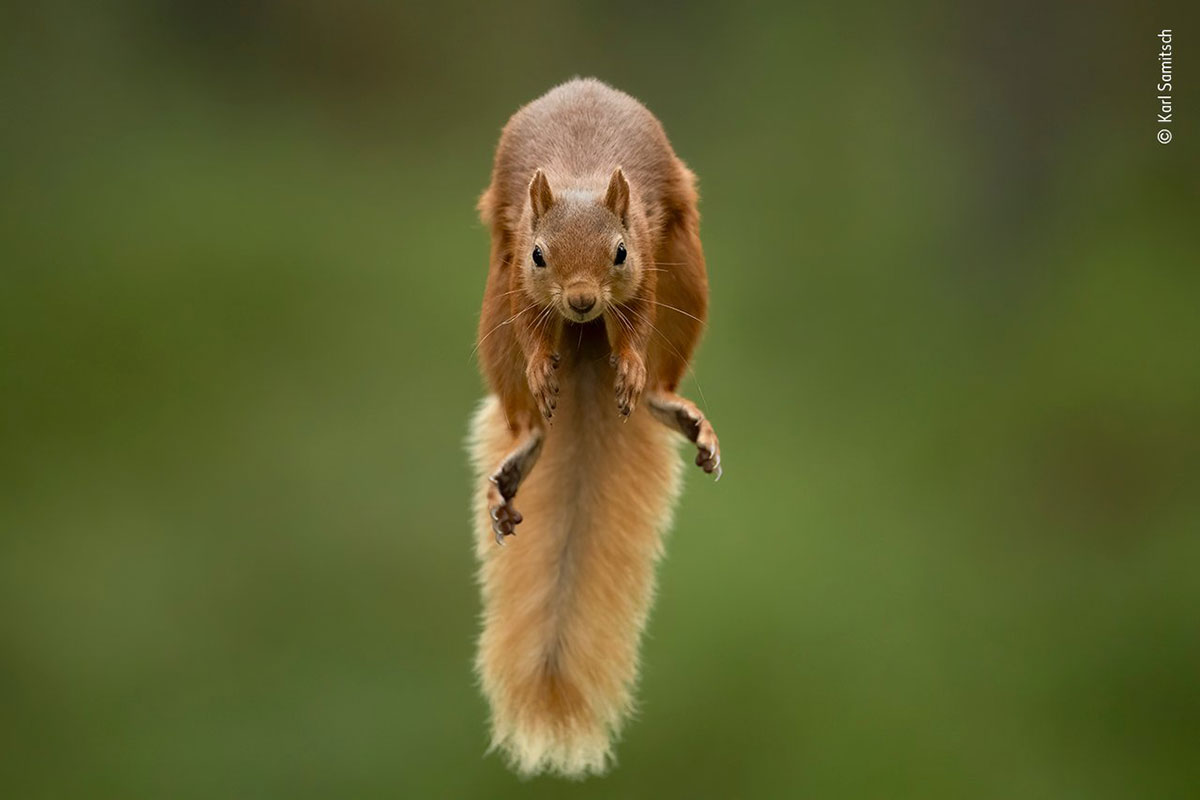
Carl’s friend took him to a forest in Scotland where red squirrels used to take food from people. They put the hazelnuts on opposite branches of two trees. Carl then placed his camera on a tripod between the components, facing the direction the squirrel might jump. He set his camera to auto-focus and waited behind a tree in camouflage. After less than an hour, two squirrels appeared. As they bounced between the branches, he used his camera’s high-speed mode and captured many images. Out of all of them, only four were able to capture the moment beautifully.
Life in black and white
By Lucas Bustamante, Ecuador

Dozens of zebras had come to drink at the Okaukuejo water hole in Namibia’s Etosha National Park (a popular place for animals in the region to quench their thirst from the intense heat of the sun). The zebras, close together and moving in groups, had lowered their heads to drink water. They raised their heads like robots every few moments to check their surroundings for possible dangers. This went on for five minutes, and the stripes on the zebras’ bodies reminded Lucas of a living barcode. He tried very hard to press the camera’s shutter when only one of them raised his head. Just moments before the herd of zebras left the scene, Lucas managed to capture an image that showcased the black and white animals at their best.
All together
By Lee Dong, USA
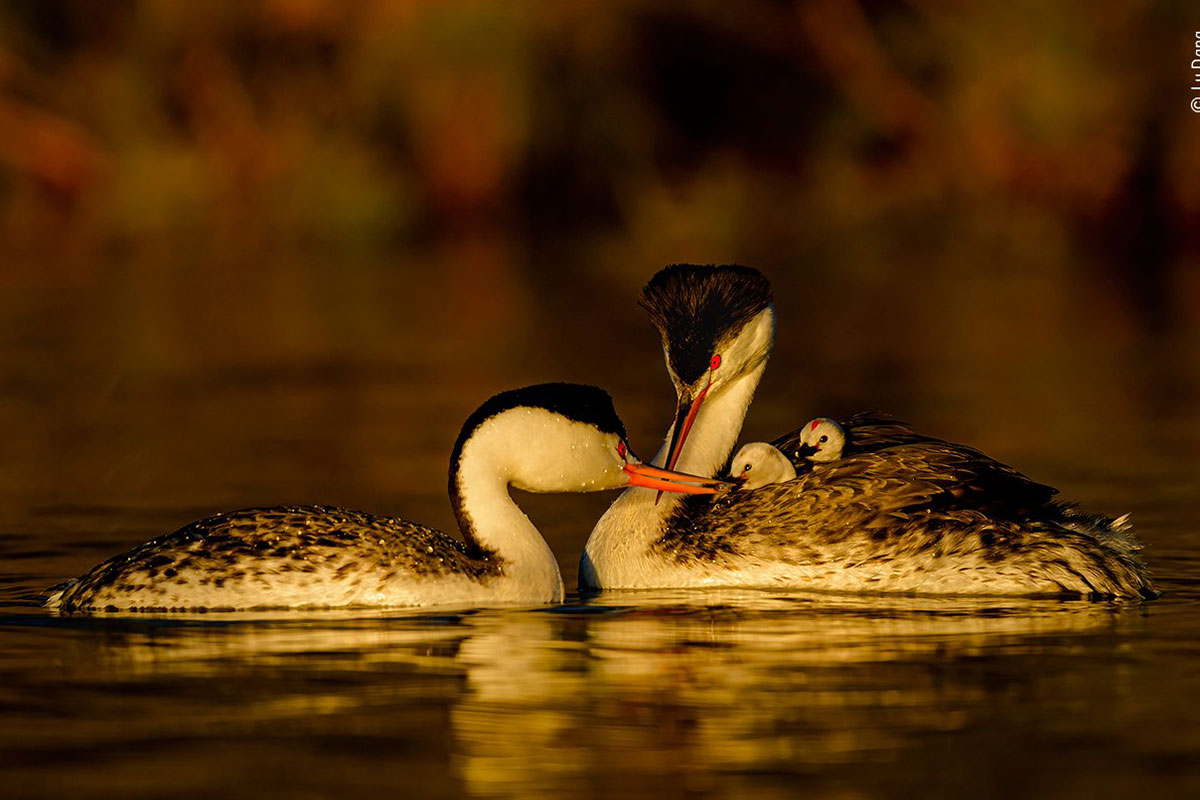
The mallards had not nested at Lee’s local lake in San Diego, California, USA. Dang wasn’t sure if the scorching and dry weather was to blame or if some other factor caused the behavior. Then in 2017, California experienced twice its average annual rainfall. As the lakes filled, the ducks started building nests and laying eggs again. They build floating nests at the edge of shallow water, among reeds or beech. Chicks ride on their parents’ backs immediately after hatching. This photo was taken a few days after a storm that unfortunately destroyed almost all the ducks’ nests. Lee spent hours on a boat surveying the environment to capture the image until he finally managed to capture such an image.
Breath of an Arctic fox
By Marco Gaiotti, Italy

Marco was watching this little arctic fox calling incessantly to another fox nearby. After a while, Gayotti noticed that the fox’s wet breath quickly froze in the air. When the photo was taken, it was late winter, and the cold Arctic air showed minus 31 degrees Celsius on the thermometer. Arctic foxes are often frustrating to photograph as they usually run around quickly in search of food, but this one was very calm and allowed Marco to get close enough. Finally, Marco was able to capture such a beautiful image.
stay close
By Maxime Aliaga, France
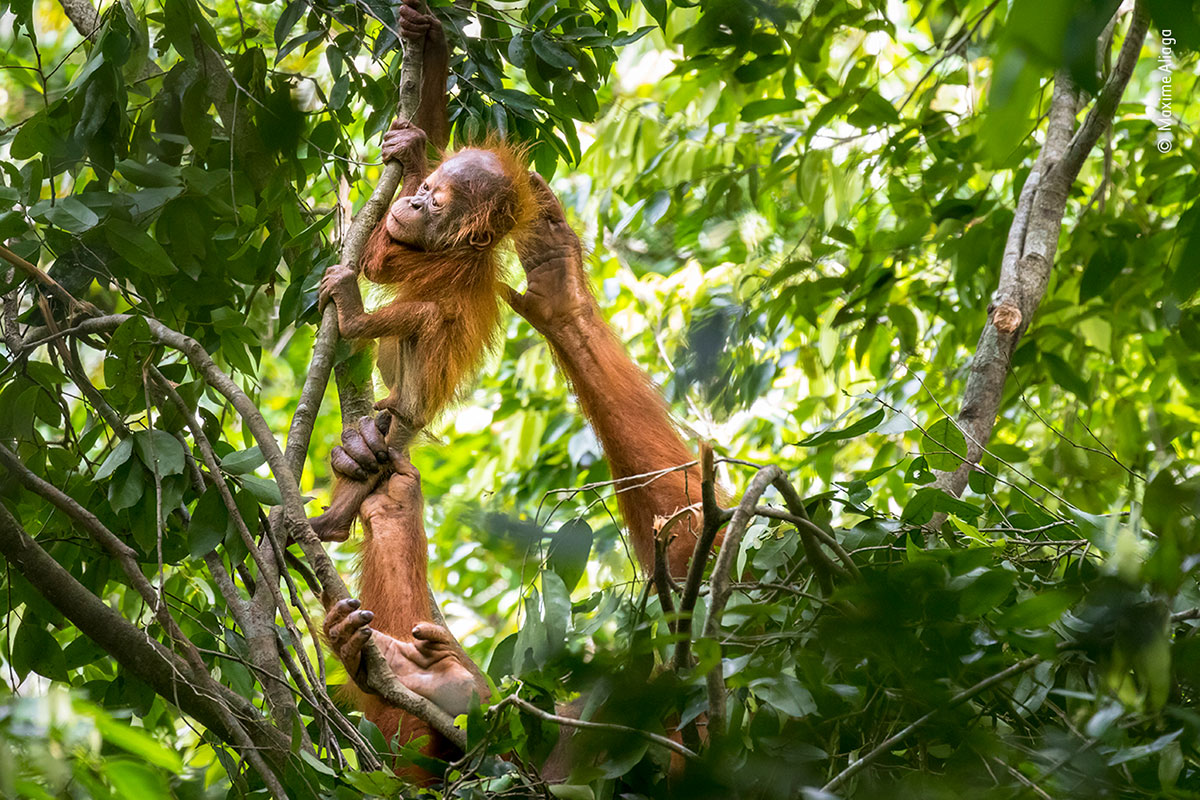
Caring for young orangutans requires a lot of energy. Maxim spent more than an hour observing this mother in the Janto Pine Nature Reserve in Sumatra, Indonesia. The mother was trying to keep her excited baby in the nest. As of 2011, the Sumatran Orangutan Conservation Program maintains more than 120 monkeys in the area. The goal of the program is to protect orangutans and prevent their decline. The mother was once held in captivity as an illegal pet but was cared for so that she could be returned to her natural environment, which happened in 2011. In 2017, she was spotted with a wild baby named Masen, a symbol of hope for the future population.
Dolly Moshe (Peek a boo)
By Michel van Knoppen, Netherlands
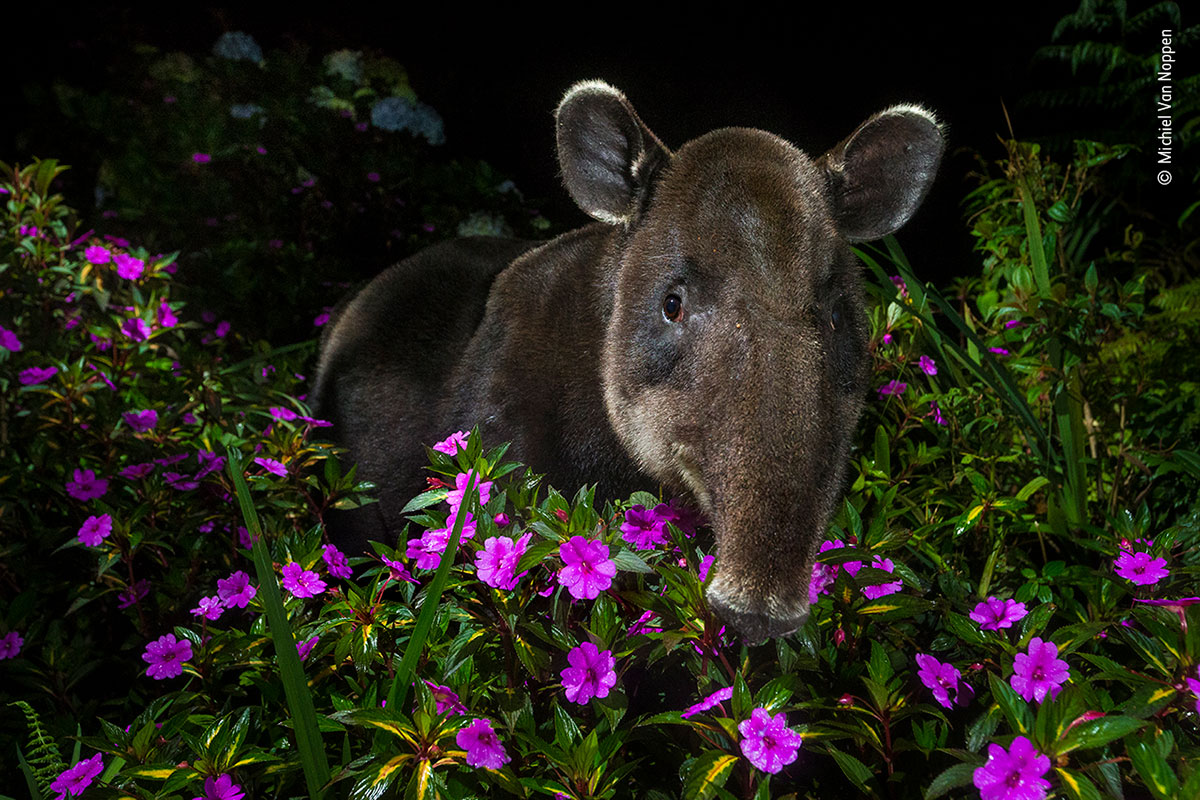
Michelle took this photo on the slopes of Braulio Carrillo National Park, near San Jose in central Costa Rica. “Tapir Bird” or “forest gardener” is an animal that is very important for the natural habitat. Still, due to threats from deforestation and hunting, it is estimated that only 6,000 of them remain in the wild. Conservation groups such as Proyecto Tapir Nicaragua and Nai Conservation have been created to work closely with local communities to promote the importance of land conservation and the protection of endangered species.
Working together
By Minghui Yuan, China

Several thick trees were near the Minghui Hotel in the Xishuangbanna Tropical Botanical Garden in China’s Yunnan Province. Ewan noticed the ants on the trunks, and their behavior attracted him. One morning, Minghui saw a group of ants working together to tame a green katydid. This species of ants build their nest on the top of the tree, are wild, and are good at catching all kinds of insects. Ants do not always kill their prey, and it has been seen that they sometimes use them for other purposes. For example, these ants protect a grasshopper species from predators and parasites so they can feed on the sweet sap they secrete.
Bonds of love
By Peter Delaney, Ireland / South Africa

Peter looked at a herd of elephants huddled together, pushing their babies into the middle of the group for added protection. A black elephant was trying to separate a newborn baby from its mother. Peter was photographing the herd in South Africa’s Addo Elephant Reserve when the infant baby screamed. The pack of elephants immediately reacted to this sound. They blew their trunks, flicked their ears, then surrounded the children. Elephants form bonds that last a lifetime and can show emotions ranging from love to anger. Peter feels “something magical and beautiful happens when you see elephants, and they touch your soul.”
Dancing in the snow
By Kiang Guo, China
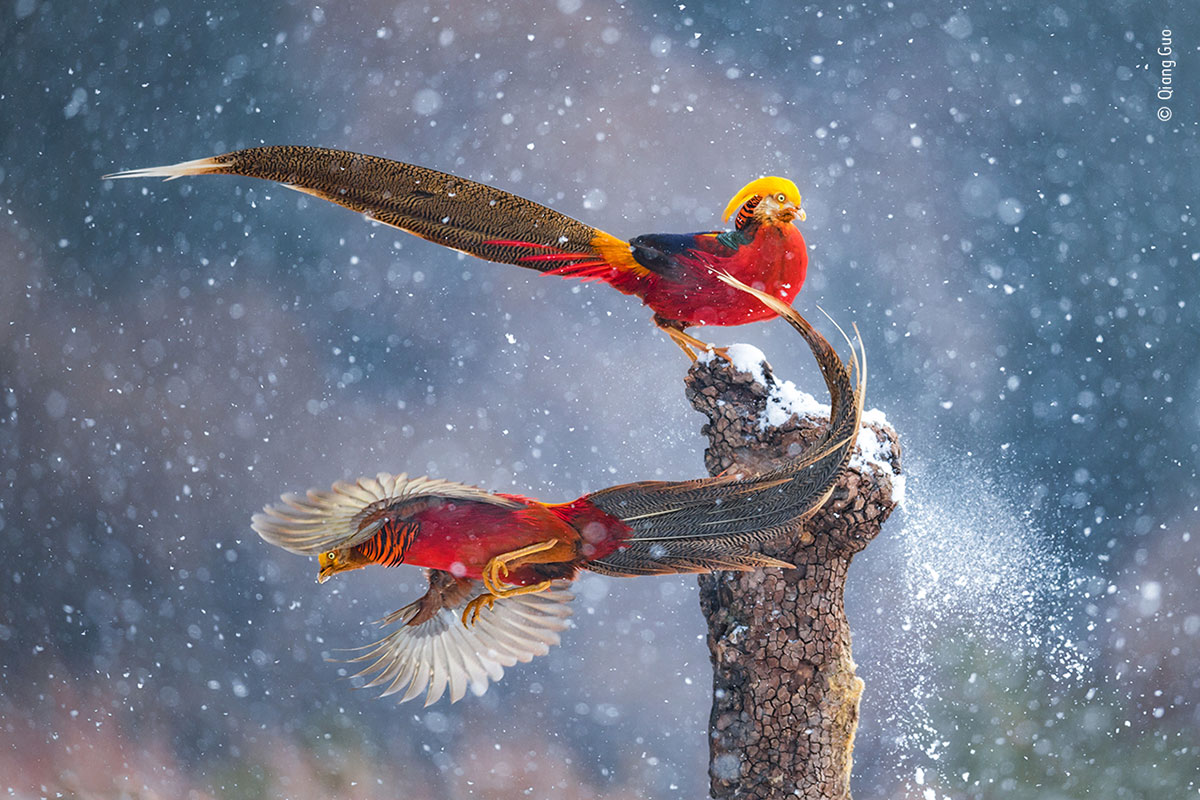
In the Lishan Nature Reserve in Shaanxi Province, China, Qiang saw two male golden pheasants constantly changing positions on the trunk; Their movements resembled a silent dance in the snow. They are native birds of China and live in dense forests in mountainous areas. Although brightly colored, they are shy and hard to spot. These birds spend most of their time searching for food on the dark forest floor and fly very high in trees only to escape predators or at night.
Meercats put on a pose.
By Thomas Peshek, Germany/South Africa
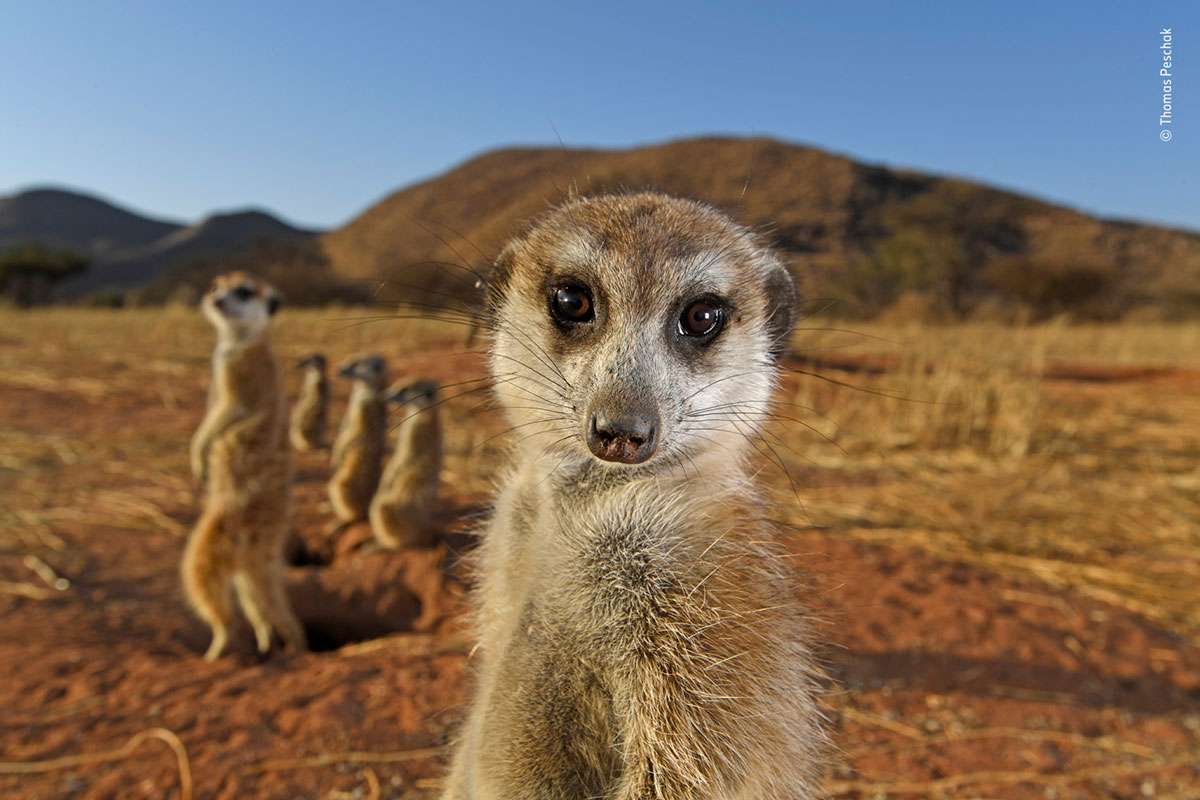
This group of meerkats has lived in South Africa’s Tswalu Kalahari Game Reserve for more than a decade, so they are now used to humans and are very calm around people. They almost ignored Thomas’s presence because they were too busy resting, hunting, cleaning, and fighting, So he was able to get up close and use his wide-angle lens to capture the dry plains and mountains these creatures call home. He used portrait photography techniques and studio lights to capture the meerkat’s features.
hitching a ride
By Wim van den Heever, South Africa
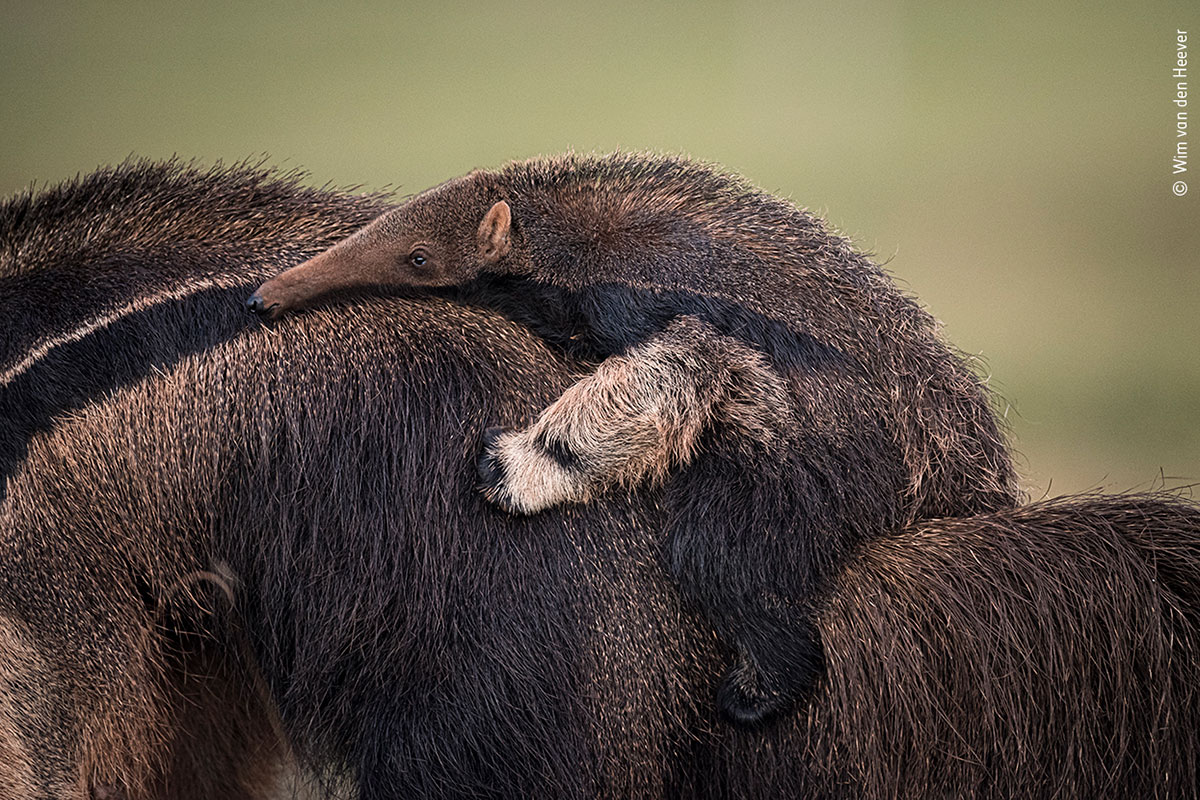
A female giant anteater was searching for food in the Brazilian Pantanal when Wim suddenly noticed that this animal had a baby on its back. He instinctively grabbed his camera and slowly walked towards the termite hill. He sat quietly and waited for the anteater to go his way, But the light was going fast, and he wondered if he could capture a good picture in such conditions. After waiting for a while (anteaters stroll) and bearing the weight of some equipment, Wim captured a beautiful image.
Barracudas
By Yong Sen Wu, Taiwan

A large concentration of fish in Palau’s Blue Corner, in the western Pacific Ocean, caught Young’s attention while diving. He had been swimming with them for four days, But their shape kept changing, and he couldn’t find the ideal angle. On the fifth day, luck turned to him, and the fish seemed to accept him into the group. Surrounded by barracudas, he wondered how one fish saw the other in the group. The fish was fast, and he had to swim hard. At the end of 50 exhausting minutes, he recorded his perfect “fish eye” view.
monkey hug
By Zhang Qiang, China

Zhang was visiting China’s Qinling Mountains to observe the behavior of the Sichuan probosci’s monkey. Temperate mountain forests are the only habitat of these endangered monkeys.
Zhang likes to watch the dynamics of monkey family groups; How close and friendly they are to each other. Females and young people huddle together for warmth and protection when it’s time to rest.
This image perfectly captures that moment of intimacy. The monkey face of a child sleeping between two materials conveys a sense of security and peace to the audience.











